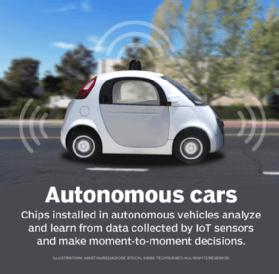artificial intelligence of things (AIoT)
What is AIoT (artificial intelligence of things)?
Artificial intelligence of things (AIoT) is the combination of artificial intelligence (AI) technologies and the internet of things (IoT) infrastructure. AIoT's goal is to create more efficient IoT operations, improve human-machine interactions and enhance data management and analytics.
AI is the simulation of human intelligence processes by machines, especially computer systems, and is typically used in natural language processing, speech recognition and machine vision.
IoT is a system of interrelated computing devices, mechanical and digital machines or objects with unique identifiers and the ability to transfer data over a network without requiring human-to-human or human-to-computer interaction. A thing in IoT can be a person's heart monitor implant, an automobile with built-in sensors to alert the driver when tire pressure is low, or any other object that can be assigned an Internet Protocol address and transfer data over a network.
AIoT is transformational and mutually beneficial for both types of technology, as AI adds value to IoT through machine learning capabilities and improved decision-making processes, while IoT adds value to AI through connectivity, signaling and data exchange. AIoT can improve businesses and their services by creating more value out of IoT-generated data. AI enables the IoT device to use gathered big data to better analyze, learn and make decisions without the need for a human.
How does AIoT work?
In AIoT devices, AI is embedded into infrastructure components, such as programs and chipsets, which are all connected using IoT networks. APIs are then used to ensure all hardware, software and platform components are able to operate and communicate together without effort from the end user.
When operational, IoT devices create and gather data, and then AI analyzes it to provide insights and improve efficiencies and productivity. Insights are gained by AI using processes like data learning.
AIoT data can also be processed at the edge, meaning the data from IoT devices is processed as close to these devices as possible to minimize the bandwidth needed to move data while avoiding possible delays to data analysis.

Applications and examples of AIoT
Although many AIoT applications focus on the implementation of cognitive computing in consumer appliances, the following highlights several examples of the wider use of AIoT:
- Smart cities. Smart technology such as sensors, lights and meters are used to collect data that is designed to help improve operational efficiency, drive economic growth and improve quality of life for residents.
- Smart retail. Retailers use smart cameras to recognize shoppers' faces and detect if they have scanned their items at the self-checkout before leaving the store.
- Smart home Smart appliances learn through human interaction and response. AIoT appliances can also store and learn from user data to understand user habits to provide customized support.
- Enterprise and industrial. Manufacturers use smart chips to detect when equipment is not functioning properly, or a part needs to be replaced.
- Social media and human resources (HR). AIoT tools can be integrated with social media and HR-related platforms to create an AI decision as a service function for HR professionals.
- Autonomous vehicles. Autonomous vehicles rely on multiple video camera and sensor systems to gather data about nearby vehicles, monitor driving conditions and look for pedestrians.
- Autonomous delivery robots. Sensors gather data about the robot's environment, for example a warehouse, and then use AI to make traversal-based decisions.
- Healthcare. Medical devices and wearables collect and monitor real-time health data, such as heart rate, and can delete irregular heartbeats.
What are the benefits and challenges of AIoT?
Benefits of AIoT include the following:
- Increased operational efficiency. AI-integrated IoT devices can analyze data to reveal patterns and insights and adjust system operations to become more efficient.
- Ability to adjust on the fly. Data can be generated and analyzed to identify points of failure, which enable the system to make adjustments as needed.
- Data analytics done by AI. Employees do not have to spend as much time monitoring IoT devices, thus saving money.
- Scalability. The number of devices connected to an IoT system can be increased to optimize existing processes or introduce new features.
But there are also instances where AIoT may fail, causing a backup in production or other negative consequences. For example, autonomous delivery robots that fail might cause a delay in the delivery of a product; smart retail stores could fail to read a customer's face, leading to the customer accidently stealing a product; or an autonomous vehicle may fail to read its surroundings, like an oncoming stop sign, and cause an accident.
What is the future of AIoT?
With the integration of AI, IoT creates a much smarter system. The goal is to have these systems make accurate judgments without the need for human intervention. One of the bigger possible innovations in AIoT is the inclusion of 5G. 5G is designed to enable faster transfer of large data files in IoT devices, through its higher bandwidth and lower latency. AIoT could help solve existing operational problems, such as the expense associated with effective human capital management or the complexity of supply chains and delivery models.
Learn how AIoT is being used today and how businesses, including manufacturing, sales, marketing, and automotive are using it to help predict and take preemptive actions.








